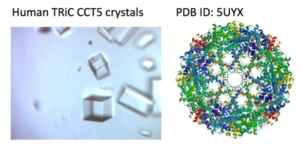X-ray crystallography has been the most successful technique used to solve macromolecular structures, contributing several thousand new entries to the Protein Data Bank (PDB) every year. The protein crystal is the critical starting point for X-ray data collection, and consequently, its properties are correlated with the quality of the data, in the form of electron density maps, and the level of detail that can be extracted for a macromolecular structure. However, proteins require solutions of specific composition to form crystals for structure determination studies. These specifications are usually determined from exposing the protein to several different solutions in a crystallization screen.

A team of researchers in the Molecular Biophysics and Integrated Bioimaging (MBIB) Division at the Lawrence Berkeley National Laboratory led by Jose Henrique Pereira and Paul Adams published a paper describing a novel crystallization screen in the Journal of Applied Crystallography. Using statistical analysis of the Biological Macromolecule Crystallization Database, combined with previous knowledge about crystallization reagents, they created a crystallization screen called Berkeley Screen. Pereira and co-authors Ryan McAndrew and Giovani Tomaleri extensively used the set of 96 solutions present in the Berkeley Screen to crystallize target proteins from the Joint BioEnergy Institute (JBEI). In addition, the Berkeley Screen was used to crystallize targets from the Collaborative Crystallography program led by Banumathi Sankaran at the Berkeley Center for Structural Biology.

The screen is available to everyone, having been published open source and with recipes for all 96 conditions. A few weeks after the paper was published, the researchers were contacted by a company that provides crystallography products expressing their interest in producing it for their customers. Now the Berkeley Screen is commercially available to the crystallography community. “To see the results from our research become a real commercial product is very rewarding,” said Tomaleri, a JBEI researcher. Pereira added, “Understanding the factors involved in crystallization is an essential step to selecting a good set of solutions. The Berkeley Screen has been a valuable protein crystallization screen providing crystals for several publications in the past few years. I am glad that it can now benefit the larger community.”



